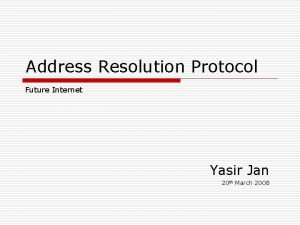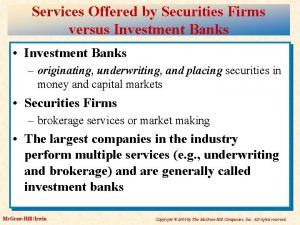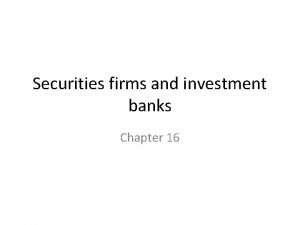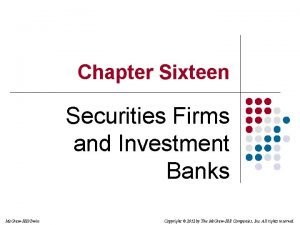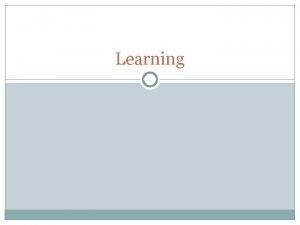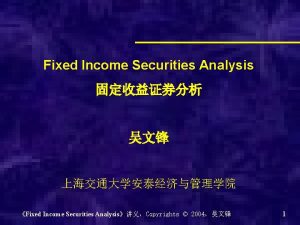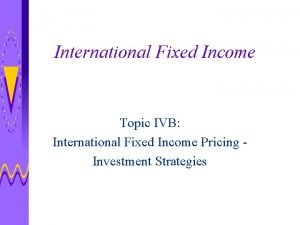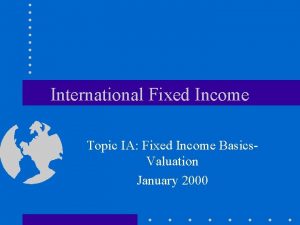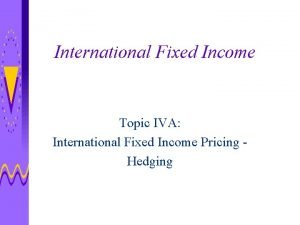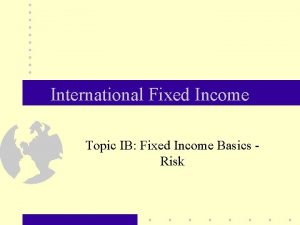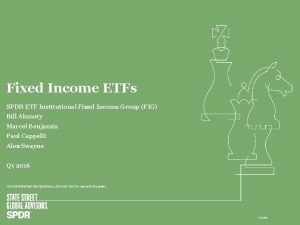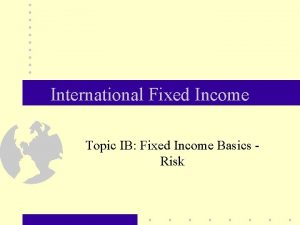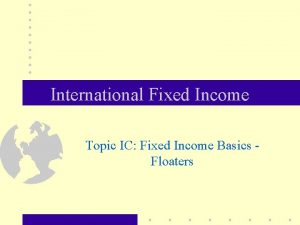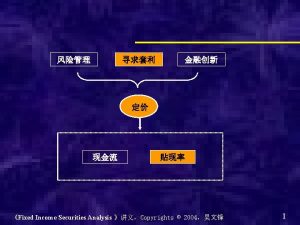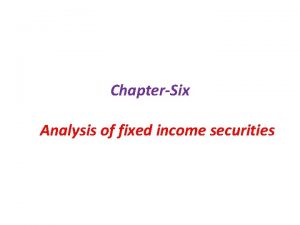Investment Analysis Lecture 16 contd Fixed Income Securities












- Slides: 12

Investment Analysis Lecture 16 (cont’d …) Fixed Income Securities Valuation & Arbitrage

Investment Analysis Fixed Income Terminologies • We frequently refer to fixed income securities as bonds. • A zero coupon bond (or zero) promises a single cash flow, face value (or par value) at some future date, maturity. • A coupon bond promises a periodic cash flow, coupon and the face value at maturity. The coupon rate is the ratio of the coupon to the face value. Coupon payments are typically semiannual for US bonds and annual for European bonds. • The time to maturity is the length of time until maturity. • For notational simplicity, we assume from now on that bonds have a face value of $100. this is equivalent to expressing bond prices as a percentage of face value.

Investment Analysis • Cash flows of a zero coupon bond with 3 years to maturity. Cash flow 0 0 100 Year • 2 3 Cash flows of a bond with coupon rate 8. 5%, annual coupon payments and 4 years to maturity. Cash flow 8. 5 108. 5 Year • 1 1 2 3 4 Cash flows of a bond with coupon rate 10%, semiannual coupon payments and 2 years to maturity. Cash flow 5 5 5 105 Year 0. 5 1 1. 5 2

Investment Analysis Treasury Securities • Fixed income securities generally involve default risk, the risk that the issuer will not meet the cash flow obligations. • The only fixed income securities that involve virtually no default risk are US Treasury Securities. We will focus on these securities because they are the simplest to value. • The Treasury issues have three types of securities: – Treasury Bills (T-Bills): Maturities up to 1 year. No coupon. – Treasury Notes (T-Notes): Maturities between 1 and 10 years. Semiannual coupon. – Treasury Bonds (T-Bonds): Maturities greater than 10 years. Semiannual coupon. • The Treasury allows buyers of T-Notes and T-Bonds to exchange them for the individual coupons and face value. These zero coupon bonds can be traded and are called Treasury Strips (T-Strips).

Investment Analysis Term Structure • • • To value fixed income securities, it is essential to know the spot rate for each maturity. The term structure of spot rates (or yield curves) represents the spot rates as a function of maturity. The term structure can have many shapes: – It is generally upward sloping. This means that spot rates for long maturities are generally higher than those for short maturities. – However, it can also be hump shaped, inverted hump shaped, or downward sloping. – Upward sloping term structures are associated with periods of economic expansion. – Downward sloping term structures are associated with periods of economic slowdown/recession. • Spot rates, both for short and long maturities move substantially over time.

Investment Analysis Valuation of Fixed Income Securities Zero Coupon Bonds Consider a zero coupon bond with T years to maturity. The PV of the bond’s cash flows will be: 100 PV = (1 + r. T)t Where: r. T = T year spot rate. T = Time period/maturity PV = Present value/Price of the bond • • • A zero coupon bond is always sold at “discount” below face value. • ASSIGNMENT (QUESTION 1) The 4 year spot rate is 5%. Compute the price of a zero coupon bond with 4 years to maturity.

Investment Analysis Valuation of Fixed Income Securities (cont’d …) Coupon Bonds • • Consider a bond with annual coupon rate c% (i. e. , annual coupon payments of c) and T years to maturity. The PV of the bond’s cash flows will be: c c 100 + c PV = + + ……. . + (1+r 1) (1+r 2)2 (1+r. T)T A coupon bond may sell at discount (below face value), at par (at face value) or at premium (above face value). ASSIGNEMENT (Question 2) The 1 year spot rate is 6%, the 2 year spot rate is 6. 5% and the 3 year spot rate is 6. 7%. Compute the price of a bond with annual coupon rate 8% and 3 years to maturity

Investment Analysis Valuation of Fixed Income Securities • Consider a bond with semiannual coupon rate c%, (i. e. , semiannual coupon payments of c/2) and T years to maturity. Assume that the spot rates are quoted as semiannual APRs. The PV of the bond’s cash flows will be: c/2 100 + c/2 PV = + + (1+r 0/2) (1+r 1/2)2 (1+r. T/2)T • ASSIGNMENT (QUESTION 1) Suppose that r 0. 5 = 8%, r 1 = 8. 2%, r 1. 5 = 8. 6% and r 2 = 9%. Compute the price of a bond with semiannual coupon rate 8% and 2 years to maturity. •

Investment Analysis Obtaining Spot Rates • • So far, we took the spot rates as given. But how can we obtain them? Recall that the price of a zero coupon bond with T years to maturity is: 100 = 100 x d. T (1+r)T • Therefore, we can obtain: – The discount factor d. T, by dividing the price by 100. (d. T = Price / 100) – The T year spot rate, by 1 d. T = (1 + r)T 1 = r. T = 1/T d. T 1

Investment Analysis Valuation via Zero Coupon Bonds : An Example • • Consider a coupon bond with annual coupon rate 10% and 3 years to maturity. Cash flows are Cash flow 10 10 110 Year • • 1 2 3 Suppose that the prices of zero coupon bonds with maturities 1, 2 and 3 years are 95, 88 and 80 respectively. The price of the coupon bond is: Price = 10 x d 1 + 10 x d 2 + 110 x d 3 = 10 x 0. 95 + 10 x 0. 88 + 110 x 0. 8 = 106. 3

Investment Analysis Yield to Maturity (YTM) • • The YTM of a bond is the discount rate that equates the PV of the bond’s cash flows to the bond’s price. Viewing the bond as an “investment project, ” the YTM is simply the bond’s IRR. For a bond with annual coupon rate c% and T years to maturity, the YTM (y) is given by: c c 100 + c Price = + + ……. . + (1+y)2 (1+y)T ASSIGNMENT (Question 2) If c = 10, T =3 and the price is 98, then YTM (y) will be?

Investment Analysis Facts about YTM The relation between a bond’s YTM and coupon rate tells us how the bond’s price compares to the face value. • If the YTM is greater than the coupon rate, then the bond sells at discount (below face value) • If the YTM is equal to the coupon rate, then the bond sells at par (at face value) • If the YTM is less than the coupon rate, then the bond sells at premium (above face value)
 Valuation of fixed income securities or valuation of bonds
Valuation of fixed income securities or valuation of bonds Valuation of fixed income securities
Valuation of fixed income securities Pricing fixed income securities
Pricing fixed income securities Parceloo
Parceloo Fixed investment and inventory investment
Fixed investment and inventory investment Cisi introduction to securities and investment
Cisi introduction to securities and investment Securities firms vs investment banks
Securities firms vs investment banks Capital markets tribunal
Capital markets tribunal Securities firms and investment banks
Securities firms and investment banks Sixteen securities inc
Sixteen securities inc Examples of partial reinforcement
Examples of partial reinforcement Tolmans rat experiment
Tolmans rat experiment Fixed interval vs fixed ratio
Fixed interval vs fixed ratio



